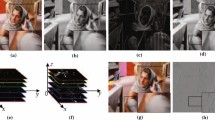Abstract
Image processing involving correlation based filter algorithms have proved extremely useful for image enhancement, feature extraction and recognition, in a wide range of medical applications, but is almost exclusively used with still images due to the amount of computations required by the correlations. In this paper, we present two different practical methods for applying correlation-based algorithms to real-time video images, using hardware accelerated correlation, as well as our results in applying the method to optical venography. The first method employs a GPU accelerated personal computer, while the second method employs an embedded FPGA. We will discuss major difference between the two approaches, and their suitability for clinical use. The system presented detects blood vessels in human forearms in images from NIR camera setup for the use in a clinical environment.









Similar content being viewed by others
Notes
Warp is a collection of threads assigned to a multiprocessor on the GPU.
Constant memory is fast read only memory for the GPU. The memory can be written from the CPU only.
Global memory is uncached off-chip memory, that is, relatively slow to access.
Texture units are interface used to speed up access to constant memory through caching.
According to the standard formats and rates in the DCAM v1.31 specifications defined by the 1394 Trade Association, the achievable frame rate on a IEEE 1394a (400Mbit) bus is 240 FPS for a 320 × 240 image and 60 FPS for a 640 × 480 image.
References
Al-rawi, M., Qutaishat. M., Arrar, M.: An improved matched filter for blood vessel detection of digital retinal images. Comput. Biol. Med. 37, 262–267 (2007). doi:10.1016/j.compbiomed.2006.03.003
Amato, N., Dale, L.: Probabilistic roadmap methods are embarrassingly parallel. In: Proceedings of the 1999 IEEE International Conference on Robotics and Automation, vol. 1 (1999)
Bayazit, M., Couture-beil, A., Mori, G.: Real-time motion-based gesture recognition using the gpu. Engineering, pp 9–12 (2009)
Chaudhuri, S., Chatterjee, S., Katz, N., Nelson, M., Goldbaum, M.: Detection of blood vessels in retinal images using two-dimensional matched filters. IEEE Trans. Med. Imaging 8(3), 263–269 (1989)
Cornelis, N., Van Gool, L.: Fast scale invariant feature detection and matching on programmable graphics hardware. In: IEEE Computer Society Conference on Computer Vision and Pattern Recognition Workshops, 2008. CVPR Workshops 2008, p. 1G8 (2008)
Filippov, A.: Encoding high-resolution ogg/theora video with reconfigurable fpgas. Xcell J. 53, 19–21 (2005)
Huang, J., Ponce, S., Park, S., Cao, Y., Quek, F.: GPU-accelerated computation for robust motion tracking using the CUDA framework. In: Visual Information Engineering, 2008, VIE 2008, 5th International Conference, p. 437G442 (2008)
Kjær-Nielsen, A., Jensen, L.B.W.: Real time machine vision on FPGA. Master thesis. http://www.mip.sdu.dk/covig/publications/AknLbwjMaster.pdf (2007)
Kjær-Nielsen, A., Jensen, L.B.W., Sørensen, A.S., Krüger, N.: A real-time embedded system for stereo vision preprocessing using an fpga. In: RECONFIG ’08: Proceedings of the 2008 International Conference on Reconfigurable Computing and FPGAs, pp 37–42 (2008)
Liu, S., Li, P., Luo, Q.: Fast blood flow visualization of high-resolution laser speckle imaging data using graphics processing unit. Opt. Express 16(19), 2188–2190 (2008)
Mizukami, Y., Tadamura, K.: Optical Flow Computation on Compute Unified Device Architecture. Processing (Iciap) (2007)
Owens, J.D.: Fast Deformable Registration on the GPU: A CUDA Implementation of Demons (2008)
Pan, L., Gu, L., Xu, J.: Implementation of Medical Image Segmentation in CUDA 1. Therapy, pp 5–8 (2008)
Podlozhnyuk, V., Howes, L., Young, E.: Image Convolution with CUDA (2007)
Savarimuthu, T.R., Soerensen, A.: Detection of vessels in human forearms using 2d matched filtering. In: Proceeding of the 10th IASTED International Conference on Signal and Image Processing, vol. 77, pp. 294–299 (2008)
Savarimuthu, T.R., Hansen, M., Ellekilde, L.P.: Tracking blood vessels in human forearms using visual servoing, pp 1–7 (2010)
Soerensen, A.S., Savarimuthu, T.R., Pedersen, E., Buc, A.G.: Tactile sensing methods for automated blood samples on humans. In: Proceedings of the 11th International Conference on Climbing and Walking Robots. CLAWAR, CLAWAR, special session on manipulation and grasping (2008)
Terriberry, T., French, L., Helmsen, J.: GPU accelerating speeded-up robust features. In: Proceedings of 3DPVT, p. 355G362 (2008)
Vermeer, K.A., Vos, F.M., Lemij, H.G., Vossepoel, A.M.: A model based method for retinal blood vessel detection. Blood 34, 209–219 (2004). doi:10.1016/S0010-4825(03)00055-6
Author information
Authors and Affiliations
Corresponding author
Rights and permissions
About this article
Cite this article
Savarimuthu, T.R., Kjær-Nielsen, A. & Sørensen, A.S. Real-time medical video processing, enabled by hardware accelerated correlations. J Real-Time Image Proc 6, 187–197 (2011). https://doi.org/10.1007/s11554-010-0185-2
Received:
Accepted:
Published:
Issue Date:
DOI: https://doi.org/10.1007/s11554-010-0185-2




